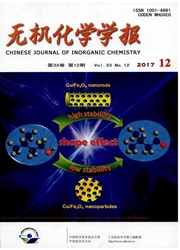

 中文摘要:
中文摘要:
合成并通过元素分析,红外和X-射线单晶衍射表征了2个酰腙铜配合物[Cu(L)2(THF] (1)和[Cu(L)(CH3OH)Cl] (2)[HL=3,4-二甲基-2-乙氧羰基-吡咯-5-甲醛苯甲酰腙].结果表明在每个配合物中,HL脱质子作为阴离子配体,通过烯醇化的氧和亚氨基的氮与中心铜(Ⅱ)离子配位.中心铜(Ⅱ)离子在配合物1和2中的配位构型分别为扭曲的四方锥和平面正方形.配合物2对金黄色葡萄球菌有明显的抑制作用(MIC=1.98μg·mL^-1),而配合物1则对肝癌细胞Hep G2展现出显著的抗肿瘤活性(IC50=9.1 μmol·L^-1).
 英文摘要:
英文摘要:
Two copper(H) complexes, [Cu(L)2 (THF] (1) and [Cu(L)(CH3OH)Cl]2 (2) (where HL=ethyl 5-[(benzoyl) amino-iminomethyl]-3,4-dimethyl-pyrrole-2-carboxylate) have been synthesized and characterized by elemental analyses, infrared spectra and single-crystal X-ray diffraction analyses. The results reveal that the acylhydrazone ligand HL in each complex is deprotonated as an anionic ligand and coordinates to the central Cu(Ⅱ) ion via enolization oxygen and imine nitrogen atoms. The Cu(ll) center possesses a distorted square-pyramidal geometry and a square-planar geometry in complex 1 and 2, respectively. Complex 2 shows obvious inhibitory effect to bacterial strain S. Aureus (MIC=1.98 μg .mL^-1), and complex 1 has excellent antitumor activity towards Hepatocellular carcinoma (Hep G2) cells (IC50=9.1 μmol·L^-1). CCDC: 1003889, HL·2CH3OH; 1003890, 1; 1003891, 2.
 同期刊论文项目
同期刊论文项目
 同项目期刊论文
同项目期刊论文
 Synthesis, crystal structure, DNA-binding properties, cytotoxic and antioxidation activities of seve
Synthesis, crystal structure, DNA-binding properties, cytotoxic and antioxidation activities of seve (E,E)-3,3 '-Dimethyl-1,1 '-diphenyl-4,4 '-{[3-azapentane-1,5-diylbis(azanediyl)]bis(phenylmethylidyn
(E,E)-3,3 '-Dimethyl-1,1 '-diphenyl-4,4 '-{[3-azapentane-1,5-diylbis(azanediyl)]bis(phenylmethylidyn Zinc Complex with Acetamide Type Ligand Bearing Quinolinyloxy Unit: Synthesis, Crystal Structure and
Zinc Complex with Acetamide Type Ligand Bearing Quinolinyloxy Unit: Synthesis, Crystal Structure and Synthesis, characterization, DNA-binding, and antioxidant activities of four copper(II) complexes co
Synthesis, characterization, DNA-binding, and antioxidant activities of four copper(II) complexes co Nickel(II) and Zinc(II) Complexes Containing Amide Type Ligand: Synthesis, Crystal Structure and Flu
Nickel(II) and Zinc(II) Complexes Containing Amide Type Ligand: Synthesis, Crystal Structure and Flu Multifunctional Fe3O4 nanoparticles for highly sensitive detection and removal of Al(III) in aqueous
Multifunctional Fe3O4 nanoparticles for highly sensitive detection and removal of Al(III) in aqueous 期刊信息
期刊信息
